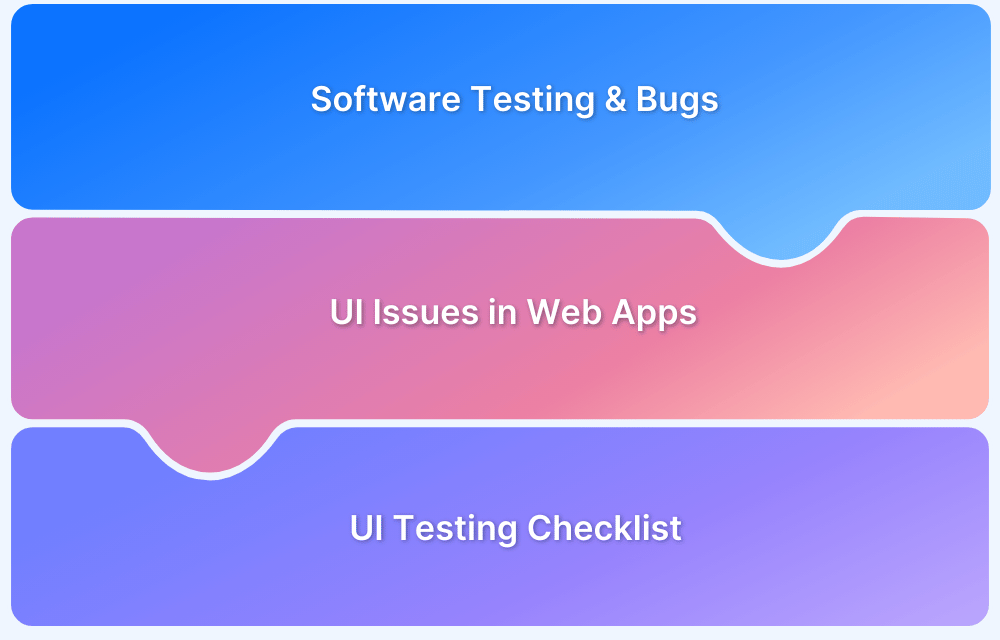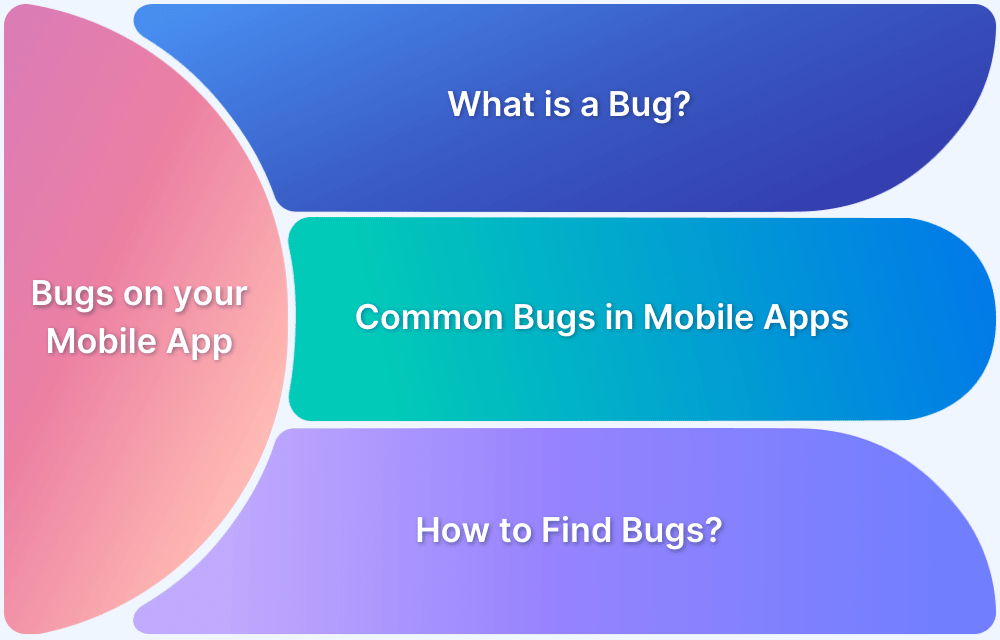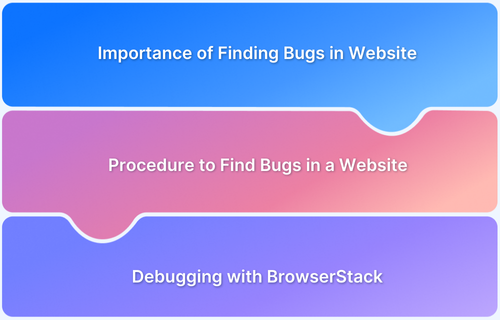Software bugs are an inevitable part of the software development life cycle. No code is perfectly crafted at its first go. Bugs, anomalies, and errors need to be identified, recorded, and resolved. Therefore, creating a robust software product requires comprehensive testing and optimizations.
Throughout the testing process, teams are bound to encounter specific bugs that obstruct the development and testing process. If these bugs are not resolved in the early stages, they will disrupt the workflow in the later stages, and fixing them becomes far more challenging and time-consuming.
However, if testers are aware of the most common types of bugs or defects they are likely to encounter, they can tackle them earlier, faster, and more effectively.
Different Types of Software Bugs
Here are the most common types of software bugs or defects encountered in software testing so that developers and testers can deal with them better.
1. Functional Bugs
Functional bugs are associated with the functionality of a specific software component.
In simple terms, any component in an app or website that doesn’t function as intended is a functional bug.
Such bugs are often detected when testers conduct comprehensive functional testing for their apps or websites in real user conditions. Teams need to ensure that all the functional bugs are resolved in the early stages so as to avoid delivering bad user experiences in the production environment.
For example, a Login button doesn’t allow users to login, an Add to cart button that doesn’t update the cart, a search box not responding to a user’s query, etc.
2. Logical Bugs
A logical bug disrupts the intended workflow of software and causes it to behave incorrectly. These bugs can result in unexpected software behavior and even sudden crashes. Logical bugs primarily take place due to poorly written code or misinterpretation of business logic.
For example of logical bugs include:
- Assigning a value to the wrong variable.
- Dividing two numbers instead of adding them together resulting in unexpected output
3. Workflow Bugs
Workflow bugs are associated with the user journey (navigation) of a software application.
Let’s consider an example of a website where a user needs to fill up a form regarding their medical history. After filling the form, the user has three options to choose from:
- Save
- Save and Exit
- Previous Page
From the available options, if the user clicks on “Save and Exit,” the user intends to save the entered information and then exit. However, if clicking on the Save and Exit button leads to an exit from the form without saving the information, it leads to a workflow bug.
4. Unit Level Bugs
Unit level bugs are very common, and they are typically easier to fix. Once the initial modules of software components are developed, developers perform unit testing to ensure that the small batches of code are functioning as expected. Here’s where developers encounter various bugs that get overlooked in the coding stages. Unit level bugs are easier to isolate as developers deal with a comparatively small amount of code. Moreover, replicating these bugs takes less time, so developers can track the exact bug and fix it in no time.
For example, if a developer creates a single page form, a unit test will verify whether all the input fields are accepting appropriate inputs and validate buttons for functionality. In case a field doesn’t accept the appropriate characters or numbers, developers encounter a unit-level bug.
Also Read: Popular Unit Testing Frameworks in Selenium
5. System-Level Integration Bugs
System-level integration bugs primarily pop up when two or more units of code written by different developers fail to interact with each other. These bugs primarily occur due to inconsistencies or incompatibility between two or more components. Such bugs are difficult to track and fix as developers need to examine a larger chunk of code. They are also time-consuming to replicate. Memory overflow issues and inappropriate interfacing between the application UI and the database are common examples of system-level integration bugs.
For example: An online booking system integrates with multiple third-party service providers (e.g., airlines, hotels). If one of the service providers experiences high latency or timeouts, the entire booking process may fail, resulting in incomplete bookings or incorrect availability information.
6. Out of Bound Bugs
Out of Bound Bugs show up when the system user interacts with the UI in an unintended manner. These bugs occur when an end-user enters a value or a parameter outside the limits of unintended use.
For example, entering a significantly larger or a smaller number or entering an input value of an undefined data type. These bugs often pop up in form validations during functional testing of web or mobile apps.
Must Read: A Detailed Guide on Bug Tracking
7. Security Bugs
Security is a major concern for software development. Security Bugs are a major risk for users and should be taken very seriously and resolved. Due to their high severity and vulnerable nature, security bugs are considered among the most sensitive bugs of all types and should be handled with criticality and urgency.
These bugs might not hinder the operation but can compromise the whole system. These should be checked thoroughly at regular intervals.
A common example is SQL injection, where an attacker can manipulate a database query to gain unauthorized access.
8. Performance Bugs
Performance bugs occur when a software application fails to meet the expected performance benchmarks, such as load times, response times, or throughput. These bugs can significantly degrade the user experience, especially in high-traffic or resource-intensive environments.
For example: An e-commerce website experiences a performance bug where the page load time exceeds 5 seconds during peak traffic hours, causing frustration for users and leading to a high abandonment rate.
9. Compatibility Bugs
Compatibility bugs arise when a software application does not function correctly across different environments, devices, or platforms. These bugs can lead to inconsistent user experiences and reduced accessibility.
For example: A mobile app works perfectly on Android devices but crashes or displays incorrectly on certain iOS devices, leading to a compatibility bug that impacts a significant portion of the user base.
10. Usability Bugs
Usability bugs affect the overall user experience, making it difficult or confusing for users to interact with the software. These bugs do not necessarily prevent functionality but can lead to poor user satisfaction and increased user error rates.
For example: A web application has a complex navigation structure that makes it difficult for users to find essential features, leading to a usability bug that frustrates users and reduces engagement.
11. Concurrency Bugs
Concurrency bugs occur in software systems that involve parallel processing or multi-threading. These bugs arise when multiple threads or processes interact in unintended ways, leading to unpredictable behavior, data corruption, or system crashes.
For example: A banking application experiences a concurrency bug where two users attempt to transfer funds simultaneously, leading to incorrect account balances or duplicate transactions.
Impact of Bugs on Software Development
Bugs can have significant impacts on software development, affecting everything from project timelines to user satisfaction. Here’s how:
- Delays in Project Delivery: Bugs, especially critical ones, can delay the release of software as developers need to spend time identifying and fixing them. This can lead to missed deadlines and increased costs.
- Increased Development Costs: The longer a bug goes undetected, the more expensive it becomes to fix. Early-stage bugs might be resolved with a few lines of code, but later-stage bugs could require extensive rework, leading to higher costs.
- Reputation Damage: If bugs make it into production, they can lead to a poor user experience, causing users to lose trust in the software. This can damage the reputation of the company and result in loss of customers.
- Security Risks: Bugs that involve security vulnerabilities can be exploited by attackers, leading to data breaches, legal liabilities, and financial losses.
- Lower Productivity: Frequent bugs can lead to a more reactive approach to development, where developers are constantly fixing issues rather than building new features. This can lower overall productivity and slow down innovation.
How to Track Defects Using BrowserStack Test Observability
Tracking defects effectively is crucial for maintaining the quality and reliability of your software. BrowserStack Test Observability offers an integrated platform that enhances defect tracking by providing comprehensive test monitoring, reporting, and debugging capabilities. Here’s how you can leverage BrowserStack Test Observability to track defects in real-time:
1. View and Debug Build Runs
BrowserStack Test Observability allows you to view and debug your build runs seamlessly. By accessing detailed logs and insights, you can quickly identify the root causes of failures and address them efficiently. The platform automatically identifies reasons for test failures, making it easier to pinpoint and fix defects.
2. Automatically Identify Flaky Tests and New Failures
One of the standout features of BrowserStack Test Observability is its ability to automatically detect flaky tests, new failures, and other anomalies. These issues are often challenging to track manually, but with Test Observability, you can rely on AI-driven failure analysis to catch them early and minimize their impact on your test suite.
3. Leverage Smart Tags for Efficient Defect Tracking
Smart Tags in BrowserStack Test Observability are automatically applied to your tests, helping you identify issues faster. These tags include:
- Flaky: Tests that produce inconsistent results.
- New Failure: Tests that have started failing recently.
- Always Failing: Tests that consistently fail.
- Performance Anomaly: Tests that exhibit unusual performance issues.
Smart Tags are enabled by default and come with configurations that should suit most teams. However, you can customize these tags with specific rules to better align with your project needs, making defect tracking more adaptable and precise.
4. Set Up Custom Alerts for Proactive Monitoring
BrowserStack Test Observability enables you to set up custom alerts based on specific rules you define for each build. For example, you can create alerts for build stability, performance, flakiness percentage, and more. If these rules are breached, an alert is triggered in the Build Insights view, allowing you to quickly assess whether any quality standards were compromised. Custom alerts can be applied globally to all builds within a project or selectively to specific builds, giving you control over how and when you are notified about potential defects.
5. Use AI-Driven Failure Analysis for In-Depth Insights
The platform’s AI-driven failure analysis is triggered after each build run and provides detailed insights into the causes of test failures. This feature works if there are failures in the current build and if similar test failures have been tagged in the past.
6. Analyze Unique Errors for Targeted Bug Fixes
The Unique Errors feature in BrowserStack Test Observability allows you to assess the impact of individual errors across your test suite. By focusing on fixing a single underlying error, you could potentially resolve multiple test failures simultaneously. This approach helps you identify patterns in your test cases or application that may contribute to recurring issues.
7. Access Comprehensive Dashboards for Test and Error Health
BrowserStack Test Observability provides access to the Test Health and Errors Health Dashboards, which offer a holistic view of your test suite’s performance. These dashboards enable you to monitor the overall health of your tests and errors, giving you actionable insights to track and resolve defects in real time.
Best Practices to Resolve Bugs Efficiently
Resolving software bugs efficiently is crucial to maintaining high-quality software and ensuring a smooth user experience. Here are some best practices to follow:
1. Prioritize Bugs Based on Severity and Impact
- Description: Not all bugs are created equal. Prioritizing bugs based on their severity and impact on the system or users helps focus resources on the most critical issues first.
- Action: Use a bug-tracking tool to categorize bugs (e.g., critical, major, minor) and address the most severe ones immediately.
2. Reproduce the Bug Consistently
- Description: A bug that can be consistently reproduced is easier to analyze and fix. Ensure that you understand the exact conditions under which the bug occurs.
- Action: Document the steps to reproduce the bug and verify them across different environments to ensure it’s not an environment-specific issue.
3. Implement Automated Testing
- Description: Automated tests help catch bugs early in the development cycle and prevent regressions. They are particularly useful for repetitive tasks and ensure consistency across test runs.
- Action: Integrate automated testing into your CI/CD pipeline to continuously test your code and catch bugs early.
4. Collaborate Across Teams
- Description: Effective communication between developers, testers, and other stakeholders is key to resolving bugs efficiently. Collaboration ensures that everyone understands the issue and works together to fix it.
- Action: Hold regular bug triage meetings to discuss and assign bug fixes, and use collaborative tools like Slack, Jira, or Trello for seamless communication.
5. Use Version Control Effectively
- Description: Version control systems like Git allow you to track changes, roll back to previous versions, and work on bug fixes in isolation without disrupting the main codebase.
- Action: Create branches for bug fixes, document the changes made, and perform code reviews before merging the fix back into the main branch.
6. Conduct Root Cause Analysis
- Description: Understanding the root cause of a bug helps prevent similar issues in the future. Rather than just fixing the symptoms, dig deeper to find out why the bug occurred.
- Action: Use tools like log analysis, debugging, and static code analysis to investigate and address the underlying cause of the bug.
7. Test Across Different Environments
- Description: Bugs can behave differently across various environments (e.g., different operating systems, browsers, or devices). Testing in multiple environments ensures that the bug is fully resolved.
- Action: Use cloud-based testing platforms like BrowserStack to test your software across a wide range of environments and configurations.
8. Document the Bug Fix Process
- Description: Proper documentation helps track the resolution process and provides valuable insights for future reference. It also aids in knowledge transfer within the team.
- Action: Maintain detailed records of the bug, including its description, root cause, steps taken to fix it, and any related code changes.
The Role of Real Devices in Bug Identification
For any software product (mobile app or web app) to be successful in a highly fragmented environment, it needs to be thoroughly tested in real user conditions. This helps in detecting and resolving the maximum bugs an end-user might encounter in the real world.
Extensive testing requires a comprehensive device lab that enables testers to test their web and mobile apps across diverse device-browser-OS combinations. Bear in mind that setting up a comprehensive testing digital lab requires significant financial investment and maintenance effort. Naturally, this is not feasible for all organizations.
Interesting Read: Understanding Browser, OS and Device Fragmentation
Cloud-based testing platforms like BrowserStack help teams of all sizes by providing them the necessary test infrastructure for comprehensive testing. One can test on a wide range of devices (mobile and desktop) running on unique operating systems like Android, iOS, Windows, or macOS.
Needless to say, the entire QA process hinges on the use of a real device cloud. This is true for manual testing and automation testing. QA’s can also choose to conduct Cypress testing on 30+ real browser versions.
Use BrowserStack’s cloud Selenium grid of 3500+ real browsers and devices to run all requisite tests in real user conditions. Manual testing is also easily accomplished on the BrowserStack cloud. Sign Up for free, choose the requisite device-browser combinations, and start testing.
Additionally, BrowserStack also offers a debugging toolkit that makes it easy to verify, debug and fix errors.
Listed below are the range of debugging tools offered by BrowserStack’s Mobile and Web testing products:
- Live: Pre-installed developer tools for desktop browsers and Chrome developer tools on real mobile devices.
- Automate: Video Recording, Screenshots, Text Logs, Network Logs, Selenium Logs, and a few others.
- App Live: Real-time Device Logs from Logcat or Console
- App Automate: Video Recording, Text Logs, Screenshots, Network Logs, Appium Logs, App Profiling, and others.
With such an inclusive test infrastructure, teams don’t need to worry about taking any additional efforts to set up a complex device lab. Simply sign-up for free -> select the desired test environment, -> start testing remotely from anywhere in the world.
As mentioned earlier, developing flawless software needs comprehensive testing, debugging, and optimizations. Regardless of the bug type, testers must ensure that the majority of bugs are identified and resolved in the early stages to avoid rework in later phases. Naturally, having clarity on the most common types of bugs will help developers avoid mistakes in the development process.







